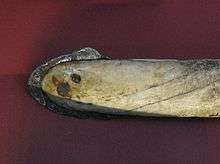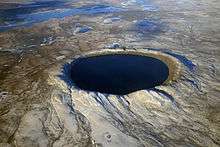Meteorite
A meteorite is a solid piece of debris from an object, such as a comet, asteroid, or meteoroid, that originates in outer space and survives its passage through the atmosphere to reach the surface of a planet or moon. When the original object enters the atmosphere, various factors such as friction, pressure, and chemical interactions with the atmospheric gases cause it to heat up and radiate energy. It then becomes a meteor and forms a fireball, also known as a shooting star or falling star; astronomers call the brightest examples "bolides". Once it settles on the larger body's surface, the meteor becomes a meteorite. Meteorites vary greatly in size. For geologists, a bolide is a meteorite large enough to create an impact crater.[2]
Meteorites that are recovered after being observed as they transit the atmosphere and impact the Earth are called meteorite falls. All others are known as meteorite finds. As of August 2018, there were about 1,412 witnessed falls that have specimens in the world's collections.[3] As of 2018, there are more than 59,200 well-documented meteorite finds.[4]
Meteorites have traditionally been divided into three broad categories: stony meteorites that are rocks, mainly composed of silicate minerals; iron meteorites that are largely composed of metallic iron-nickel; and stony-iron meteorites that contain large amounts of both metallic and rocky material. Modern classification schemes divide meteorites into groups according to their structure, chemical and isotopic composition and mineralogy. Meteorites smaller than 2 mm are classified as micrometeorites. Extraterrestrial meteorites are such objects that have impacted other celestial bodies, whether or not they have passed through an atmosphere. They have been found on the Moon.[5][6] and Mars.[7]
Naming
Meteorites are always named for the places they were found, where practical, usually a nearby town or geographic feature. In cases where many meteorites were found in one place, the name may be followed by a number or letter (e.g., Allan Hills 84001 or Dimmitt (b)). The name designated by the Meteoritical Society is used by scientists, catalogers, and most collectors.[8]
Fall phenomena
Most meteoroids disintegrate when entering the Earth's atmosphere. Usually, five to ten a year are observed to fall and are subsequently recovered and made known to scientists.[9] Few meteorites are large enough to create large impact craters. Instead, they typically arrive at the surface at their terminal velocity and, at most, create a small pit.

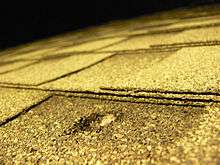
Large meteoroids may strike the earth with a significant fraction of their escape velocity (second cosmic velocity), leaving behind a hypervelocity impact crater. The kind of crater will depend on the size, composition, degree of fragmentation, and incoming angle of the impactor. The force of such collisions has the potential to cause widespread destruction.[10][11] The most frequent hypervelocity cratering events on the Earth are caused by iron meteoroids, which are most easily able to transit the atmosphere intact. Examples of craters caused by iron meteoroids include Barringer Meteor Crater, Odessa Meteor Crater, Wabar craters, and Wolfe Creek crater; iron meteorites are found in association with all of these craters. In contrast, even relatively large stony or icy bodies like small comets or asteroids, up to millions of tons, are disrupted in the atmosphere, and do not make impact craters.[12] Although such disruption events are uncommon, they can cause a considerable concussion to occur; the famed Tunguska event probably resulted from such an incident. Very large stony objects, hundreds of meters in diameter or more, weighing tens of millions of tons or more, can reach the surface and cause large craters but are very rare. Such events are generally so energetic that the impactor is completely destroyed, leaving no meteorites. (The very first example of a stony meteorite found in association with a large impact crater, the Morokweng crater in South Africa, was reported in May 2006.[13])
Several phenomena are well documented during witnessed meteorite falls too small to produce hypervelocity craters.[14] The fireball that occurs as the meteoroid passes through the atmosphere can appear to be very bright, rivaling the sun in intensity, although most are far dimmer and may not even be noticed during the daytime. Various colors have been reported, including yellow, green, and red. Flashes and bursts of light can occur as the object breaks up. Explosions, detonations, and rumblings are often heard during meteorite falls, which can be caused by sonic booms as well as shock waves resulting from major fragmentation events. These sounds can be heard over wide areas, with a radius of a hundred or more kilometers. Whistling and hissing sounds are also sometimes heard but are poorly understood. Following the passage of the fireball, it is not unusual for a dust trail to linger in the atmosphere for several minutes.
As meteoroids are heated during atmospheric entry, their surfaces melt and experience ablation. They can be sculpted into various shapes during this process, sometimes resulting in shallow thumbprint-like indentations on their surfaces called regmaglypts. If the meteoroid maintains a fixed orientation for some time, without tumbling, it may develop a conical "nose cone" or "heat shield" shape. As it decelerates, eventually the molten surface layer solidifies into a thin fusion crust, which on most meteorites is black (on some achondrites, the fusion crust may be very light-colored). On stony meteorites, the heat-affected zone is at most a few mm deep; in iron meteorites, which are more thermally conductive, the structure of the metal may be affected by heat up to 1 centimetre (0.39 in) below the surface. Reports vary; some meteorites are reported to be "burning hot to the touch" upon landing, while others are alleged to have been cold enough to condense water and form a frost.[15][16][17]
Meteoroids that experience disruption in the atmosphere may fall as meteorite showers, which can range from only a few up to thousands of separate individuals. The area over which a meteorite shower falls is known as its strewn field. Strewn fields are commonly elliptical in shape, with the major axis parallel to the direction of flight. In most cases, the largest meteorites in a shower are found farthest down-range in the strewn field.
Meteorite types
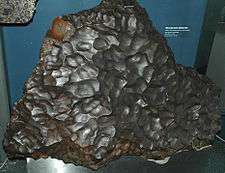
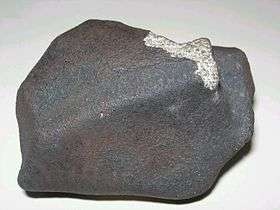
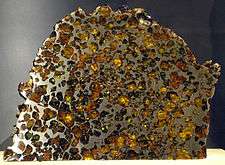
Most meteorites are stony meteorites, classed as chondrites and achondrites. Only about 6% of meteorites are iron meteorites or a blend of rock and metal, the stony-iron meteorites. Modern classification of meteorites is complex. The review paper of Krot et al. (2007)[18] summarizes modern meteorite taxonomy.
About 86% of the meteorites are chondrites,[4][19][20] which are named for the small, round particles they contain. These particles, or chondrules, are composed mostly of silicate minerals that appear to have been melted while they were free-floating objects in space. Certain types of chondrites also contain small amounts of organic matter, including amino acids, and presolar grains. Chondrites are typically about 4.55 billion years old and are thought to represent material from the asteroid belt that never coalesced into large bodies. Like comets, chondritic asteroids are some of the oldest and most primitive materials in the solar system. Chondrites are often considered to be "the building blocks of the planets".
About 8% of the meteorites are achondrites (meaning they do not contain chondrules), some of which are similar to terrestrial igneous rocks. Most achondrites are also ancient rocks, and are thought to represent crustal material of differentiated planetesimals. One large family of achondrites (the HED meteorites) may have originated on the parent body of the Vesta Family, although this claim is disputed.[21][22] Others derive from unidentified asteroids. Two small groups of achondrites are special, as they are younger and do not appear to come from the asteroid belt. One of these groups comes from the Moon, and includes rocks similar to those brought back to Earth by Apollo and Luna programs. The other group is almost certainly from Mars and constitutes the only materials from other planets ever recovered by humans.
About 5% of meteorites that have been seen to fall are iron meteorites composed of iron-nickel alloys, such as kamacite and/or taenite. Most iron meteorites are thought to come from the cores of planetesimals that were once molten. As with the Earth, the denser metal separated from silicate material and sank toward the center of the planetesimal, forming its core. After the planetesimal solidified, it broke up in a collision with another planetesimal. Due to the low abundance of iron meteorites in collection areas such as Antarctica, where most of the meteoric material that has fallen can be recovered, it is possible that the percentage of iron-meteorite falls is lower than 5%. This would be explained by a recovery bias; laypeople are more likely to notice and recover solid masses of metal than most other meteorite types. The abundance of iron meteorites relative to total Antarctic finds is 0.4%.[23][24]
Stony-iron meteorites constitute the remaining 1%. They are a mixture of iron-nickel metal and silicate minerals. One type, called pallasites, is thought to have originated in the boundary zone above the core regions where iron meteorites originated. The other major type of stony-iron meteorites is the mesosiderites.
Tektites (from Greek tektos, molten) are not themselves meteorites, but are rather natural glass objects up to a few centimeters in size that were formed—according to most scientists—by the impacts of large meteorites on Earth's surface. A few researchers have favored tektites originating from the Moon as volcanic ejecta, but this theory has lost much of its support over the last few decades.
Meteorite chemistry
In March 2015, NASA scientists reported that, for the first time, complex organic compounds found in DNA and RNA, including uracil, cytosine, and thymine, have been formed in the laboratory under outer space conditions, using starting chemicals, such as pyrimidine, found in meteorites. Pyrimidine and polycyclic aromatic hydrocarbons (PAHs) may have been formed in red giants or in interstellar dust and gas clouds, according to the scientists.[25]
In January 2018, researchers found that 4.5 billion-year-old meteorites found on Earth contained liquid water along with prebiotic complex organic substances that may be ingredients for life.[26][27]
In November 2019, scientists reported detecting sugar molecules in meteorites for the first time, including ribose, suggesting that chemical processes on asteroids can produce some organic compounds fundamental to life, and supporting the notion of an RNA world prior to a DNA-based origin of life on Earth.[28][29]
Meteorite recovery
Falls
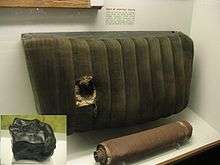
Most meteorite falls are recovered on the basis of eyewitness accounts of the fireball or the impact of the object on the ground, or both. Therefore, despite the fact that meteorites fall with virtually equal probability everywhere on Earth, verified meteorite falls tend to be concentrated in areas with high human population densities such as Europe, Japan, and northern India.
A small number of meteorite falls have been observed with automated cameras and recovered following calculation of the impact point. The first of these was the Přibram meteorite, which fell in Czechoslovakia (now the Czech Republic) in 1959.[30] In this case, two cameras used to photograph meteors captured images of the fireball. The images were used both to determine the location of the stones on the ground and, more significantly, to calculate for the first time an accurate orbit for a recovered meteorite.
Following the Pribram fall, other nations established automated observing programs aimed at studying infalling meteorites. One of these was the Prairie Network, operated by the Smithsonian Astrophysical Observatory from 1963 to 1975 in the midwestern US. This program also observed a meteorite fall, the Lost City chondrite, allowing its recovery and a calculation of its orbit.[31] Another program in Canada, the Meteorite Observation and Recovery Project, ran from 1971 to 1985. It too recovered a single meteorite, Innisfree, in 1977.[32] Finally, observations by the European Fireball Network, a descendant of the original Czech program that recovered Pribram, led to the discovery and orbit calculations for the Neuschwanstein meteorite in 2002.[33] NASA has an automated system that detects meteors and calculates the orbit, magnitude, ground track, and other parameters over the southeast USA, which often detects a number of events each night.[34]
Finds
Until the twentieth century, only a few hundred meteorite finds had ever been discovered. More than 80% of these were iron and stony-iron meteorites, which are easily distinguished from local rocks. To this day, few stony meteorites are reported each year that can be considered to be "accidental" finds. The reason there are now more than 30,000 meteorite finds in the world's collections started with the discovery by Harvey H. Nininger that meteorites are much more common on the surface of the Earth than was previously thought.
The Great Plains of the US
Nininger's strategy was to search for meteorites in the Great Plains of the United States, where the land was largely cultivated and the soil contained few rocks. Between the late 1920s and the 1950s, he traveled across the region, educating local people about what meteorites looked like and what to do if they thought they had found one, for example, in the course of clearing a field. The result was the discovery of over 200 new meteorites, mostly stony types.[35]
In the late 1960s, Roosevelt County, New Mexico in the Great Plains was found to be a particularly good place to find meteorites. After the discovery of a few meteorites in 1967, a public awareness campaign resulted in the finding of nearly 100 new specimens in the next few years, with many being by a single person, Ivan Wilson. In total, nearly 140 meteorites were found in the region since 1967. In the area of the finds, the ground was originally covered by a shallow, loose soil sitting atop a hardpan layer. During the dustbowl era, the loose soil was blown off, leaving any rocks and meteorites that were present stranded on the exposed surface.[36]
Antarctica

A few meteorites were found in Antarctica between 1912 and 1964. In 1969, the 10th Japanese Antarctic Research Expedition found nine meteorites on a blue ice field near the Yamato Mountains. With this discovery, came the realization that movement of ice sheets might act to concentrate meteorites in certain areas.[38] After a dozen other specimens were found in the same place in 1973, a Japanese expedition was launched in 1974 dedicated to the search for meteorites. This team recovered nearly 700 meteorites.[39]
Shortly thereafter, the United States began its own program to search for Antarctic meteorites, operating along the Transantarctic Mountains on the other side of the continent: the Antarctic Search for Meteorites (ANSMET) program.[40] European teams, starting with a consortium called "EUROMET" in the 1990/91 season, and continuing with a program by the Italian Programma Nazionale di Ricerche in Antartide have also conducted systematic searches for Antarctic meteorites.[41]
The Antarctic Scientific Exploration of China has conducted successful meteorite searches since 2000. A Korean program (KOREAMET) was launched in 2007 and has collected a few meteorites.[42] The combined efforts of all of these expeditions have produced more than 23,000 classified meteorite specimens since 1974, with thousands more that have not yet been classified. For more information see the article by Harvey (2003).[43]
Australia
At about the same time as meteorite concentrations were being discovered in the cold desert of Antarctica, collectors discovered that many meteorites could also be found in the hot deserts of Australia. Several dozen meteorites had already been found in the Nullarbor region of Western and South Australia. Systematic searches between about 1971 and the present recovered more than 500 others,[44] ~300 of which are currently well characterized. The meteorites can be found in this region because the land presents a flat, featureless, plain covered by limestone. In the extremely arid climate, there has been relatively little weathering or sedimentation on the surface for tens of thousands of years, allowing meteorites to accumulate without being buried or destroyed. The dark colored meteorites can then be recognized among the very different looking limestone pebbles and rocks.
The Sahara
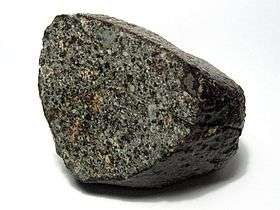
In 1986–87, a German team installing a network of seismic stations while prospecting for oil discovered about 65 meteorites on a flat, desert plain about 100 kilometres (62 mi) southeast of Dirj (Daraj), Libya. A few years later, a desert enthusiast saw photographs of meteorites being recovered by scientists in Antarctica, and thought that he had seen similar occurrences in northern Africa. In 1989, he recovered about 100 meteorites from several distinct locations in Libya and Algeria. Over the next several years, he and others who followed found at least 400 more meteorites. The find locations were generally in regions known as regs or hamadas: flat, featureless areas covered only by small pebbles and minor amounts of sand.[46] Dark-colored meteorites can be easily spotted in these places. In the case of several meteorite fields, such as Dar al Gani, Dhofar, and others, favorable light-colored geology consisting of basic rocks (clays, dolomites, and limestones) makes meteorites particularly easy to identify.[47]
Although meteorites had been sold commercially and collected by hobbyists for many decades, up to the time of the Saharan finds of the late 1980s and early 1990s, most meteorites were deposited in or purchased by museums and similar institutions where they were exhibited and made available for scientific research. The sudden availability of large numbers of meteorites that could be found with relative ease in places that were readily accessible (especially compared to Antarctica), led to a rapid rise in commercial collection of meteorites. This process was accelerated when, in 1997, meteorites coming from both the Moon and Mars were found in Libya. By the late 1990s, private meteorite-collecting expeditions had been launched throughout the Sahara. Specimens of the meteorites recovered in this way are still deposited in research collections, but most of the material is sold to private collectors. These expeditions have now brought the total number of well-described meteorites found in Algeria and Libya to more than 500.[48]
Northwest Africa
Meteorite markets came into existence in the late 1990s, especially in Morocco. This trade was driven by Western commercialization and an increasing number of collectors. The meteorites were supplied by nomads and local people who combed the deserts looking for specimens to sell. Many thousands of meteorites have been distributed in this way, most of which lack any information about how, when, or where they were discovered. These are the so-called "Northwest Africa" meteorites. When they get classified, they are named "Northwest Africa" (abbreviated NWA) followed by a number.[49] It is generally accepted that NWA meteorites originate in Morocco, Algeria, Western Sahara, Mali, and possibly even further afield. Nearly all of these meteorites leave Africa through Morocco. Scores of important meteorites, including Lunar and Martian ones, have been discovered and made available to science via this route. A few of the more notable meteorites recovered include Tissint and Northwest Africa 7034. Tissint was the first witnessed Martian meteorite fall in over fifty years; NWA 7034 is the oldest meteorite known to come from Mars, and is a unique water-bearing regolith breccia.
Arabian Peninsula

In 1999, meteorite hunters discovered that the desert in southern and central Oman were also favorable for the collection of many specimens. The gravel plains in the Dhofar and Al Wusta regions of Oman, south of the sandy deserts of the Rub' al Khali, had yielded about 5,000 meteorites as of mid-2009. Included among these are a large number of lunar and Martian meteorites, making Oman a particularly important area both for scientists and collectors. Early expeditions to Oman were mainly done by commercial meteorite dealers, however international teams of Omani and European scientists have also now collected specimens.
The recovery of meteorites from Oman is currently prohibited by national law, but a number of international hunters continue to remove specimens now deemed national treasures. This new law provoked a small international incident, as its implementation preceded any public notification of such a law, resulting in the prolonged imprisonment of a large group of meteorite hunters, primarily from Russia, but whose party also consisted of members from the US as well as several other European countries.
The American Southwest
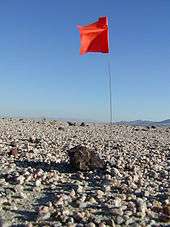
Beginning in the mid-1960s, amateur meteorite hunters began scouring the arid areas of the southwestern United States.[50] To date, thousands of meteorites have been recovered from the Mojave, Sonoran, Great Basin, and Chihuahuan Deserts, with many being recovered on dry lake beds. Significant finds include the three tonne Old Woman meteorite, currently on display at the Desert Discovery Center in Barstow, California, and the Franconia and Gold Basin meteorite strewn fields; hundreds of kilograms of meteorites have been recovered from each.[51][52][53] A number of finds from the American Southwest have been submitted with false find locations, as many finders think it is unwise to publicly share that information for fear of confiscation by the federal government and competition with other hunters at published find sites.[54][55] [56] Several of the meteorites found recently are currently on display in the Griffith Observatory in Los Angeles, and at UCLA's Meteorite Gallery.[57]
Meteorites in history
Meteorite falls may have been the source of cultish worship. The cult in the Temple of Artemis at Ephesus, one of the Seven Wonders of the Ancient World, possibly originated with the observation and recovery of a meteorite that was understood by contemporaries to have fallen to the earth from Jupiter, the principal Roman deity.[58] There are reports that a sacred stone was enshrined at the temple that may have been a meteorite. The Black Stone set into the wall of the Kaaba has often been presumed to be a meteorite, but the little available evidence for this is inconclusive.[59][60][61] Although the use of the metal found in meteorites is also recorded in myths of many countries and cultures where the celestial source was often acknowledged, scientific documentation only began in the last few centuries.
The oldest known iron artifacts are nine small beads hammered from meteoritic iron. They were found in northern Egypt and have been securely dated to 3200 BC.[62]
In the 1970s, a stone meteorite was uncovered during an archaeological dig at Danebury Iron Age hillfort, Danebury England. It was found deposited part way down in an Iron Age pit (c. 1200 BC). Since it must have been deliberately placed there, this could indicate one of the first (known) human finds of a meteorite in Europe.
Some Native Americans treated meteorites as ceremonial objects. In 1915, a 61-kilogram (135 lb) iron meteorite was found in a Sinagua (c. 1100–1200 AD) burial cyst near Camp Verde, Arizona, respectfully wrapped in a feather cloth.[63] A small pallasite was found in a pottery jar in an old burial found at Pojoaque Pueblo, New Mexico. Nininger reports several other such instances, in the Southwest US and elsewhere, such as the discovery of Native American beads of meteoric iron found in Hopewell burial mounds, and the discovery of the Winona meteorite in a Native American stone-walled crypt.[63][64]
Indigenous peoples often prized iron-nickel meteorites as an easy, if limited, source of iron metal. For example, the Inuit used chips of the Cape York meteorite to form cutting edges for tools and spear tips.
Two of the oldest recorded meteorite falls in Europe are the Elbogen (1400) and Ensisheim (1492) meteorites. The German physicist, Ernst Florens Chladni, was the first to publish (in 1794) the idea that meteorites might be rocks that originated not from Earth, but from space.[65] His booklet was "On the Origin of the Iron Masses Found by Pallas and Others Similar to it, and on Some Associated Natural Phenomena".[66] In this he compiled all available data on several meteorite finds and falls concluded that they must have their origins in outer space. The scientific community of the time responded with resistance and mockery.[67] It took nearly ten years before a general acceptance of the origin of meteorites was achieved through the work of the French scientist Jean-Baptiste Biot and the British chemist, Edward Howard.[68] Biot's study, initiated by the French Academy of Sciences, was compelled by a fall of thousands of meteorites on 26 April 1803 from the skies of L'Aigle, France.[69][70][71]
One of the leading theories for the cause of the Cretaceous–Paleogene extinction event that included the dinosaurs is a large meteorite impact. The Chicxulub Crater has been identified as the site of this impact. There has been a lively scientific debate as to whether other major extinctions, including the ones at the end of the Permian and Triassic periods might also have been the result of large impact events, but the evidence is much less compelling than for the end Cretaceous extinction.
Fatalities
Throughout history, many first- and second-hand reports abound of meteorites falling on and killing both humans and other animals. One example is from 1490 AD in China, which purportedly killed thousands of people.[72] In 1888, a meteorite reportedly killed a man and left another paralyzed in Sulaymaniyah, Iraq, according to the Ottoman Empire governor, Sultan Abdul Hamid II.[73]. John Lewis has compiled some of these reports, and summarizes, "No one in recorded history has ever been killed by a meteorite in the presence of a meteoriticist and a medical doctor" and "reviewers who make sweeping negative conclusions usually do not cite any of the primary publications in which the eyewitnesses describe their experiences, and give no evidence of having read them".[74]
The most well-known reported fatality from a meteorite impact is that of a dog killed by the fall of the Nakhla meteorite in Egypt, in 1911. This meteorite fall was identified in the 1980s as Martian in origin. A meteorite known as Valera (Venezuela 1972, see Meteorite fall) reportedly hit and killed a cow upon impact, nearly dividing the animal in two, but the fall was not reported for several decades and no evidence was preserved. There are similar unsubstantiated reports of a horse being struck and killed by a stone of the New Concord fall. Shortly after the 2007 Carancas impact event, there were rumors of a goat and a llama being killed by the impact. Again, these claims could not be verified.
The first known modern case of a human hit by a space rock occurred on 30 November 1954 in Sylacauga, Alabama.[75] A 4-kilogram (8.8 lb) stone chondrite[76] crashed through a roof and hit Ann Hodges in her living room after it bounced off her radio. She was badly bruised. The Hodges meteorite, or Sylacauga meteorite, is currently on exhibit at the Alabama Museum of Natural History.
Another claim was put forth by a young boy who stated that he had been hit by a small (~3-gram) stone of the Mbale meteorite fall from Uganda, and who stood to gain nothing from this assertion. The stone reportedly fell through banana leaves before striking the boy on the head, causing little to no pain, as it was small enough to have been slowed by both friction with the atmosphere as well as that with banana leaves, before striking the boy.[77]
Several persons have since claimed[78] to have been struck by "meteorites" but no verifiable meteorites have resulted.
Meteorite weathering
Most meteorites date from the oldest times in the solar system and are by far the oldest material available on the planet. Despite their age, they are fairly vulnerable to terrestrial environment: water, salt, and oxygen attack the meteorites as soon they reach the ground.
The terrestrial alteration of meteorites is called weathering. In order to quantify the degree of alteration that a meteorite experienced, several qualitative weathering indices have been applied to Antarctic and desertic samples.[79]
The most known weathering scale, used for ordinary chondrites, ranges from W0 (pristine state) to W6 (heavy alteration).
Fossil meteorites
"Fossil" meteorites are sometimes discovered by geologists. They represent the deeply weathered remains of meteorites that fell to Earth in the remote past and were preserved in sedimentary deposits sufficiently well that they can be recognized through mineralogical and geochemical studies. One limestone quarry in Sweden has produced an anomalously large number (more than a hundred) fossil meteorites from the Ordovician, nearly all of which are deeply weathered L-chondrites that still resemble the original meteorite under a petrographic microscope, but which have had their original material almost entirely replaced by terrestrial secondary mineralization. The extraterrestrial provenance was demonstrated in part through isotopic analysis of relict spinel grains, a mineral that is common in meteorites, is insoluble in water, and is able to persist chemically unchanged in the terrestrial weathering environment. One of these fossil meteorites, dubbed Österplana 065, appears to represent a distinct type of meteorite that is "extinct" in the sense that it is no longer falling to Earth, the parent body having already been completely depleted from reservoir of Near Earth Objects.[80]
Acfer 049, a meteorite discovered in Algeria in 1990, was shown in 2019 to have ice fossils inside it – the first direct evidence of water ice in the composition of asteroids.[81]
Notable meteorites
- Allende – largest known carbonaceous chondrite (Chihuahua, Mexico, 1969).
- Allan Hills A81005 – First meteorite determined to be of lunar origin.
- Allan Hills 84001 – Mars meteorite that was claimed to prove the existence of life on Mars.
- The Bacubirito Meteorite (Meteorito de Bacubirito) – A meteorite estimated to weigh 20–30 short tons (18–27 t).
- Campo del Cielo – a group of iron meteorites associated with a crater field (of the same name) of at least 26 craters in West Chaco Province, Argentina. The total weight of meteorites recovered exceeds 100 tonnes.[82]
- Canyon Diablo – Associated with Meteor Crater in Arizona.
- Cape York – One of the largest meteorites in the world. A 34-ton fragment called "Ahnighito", is exhibited at the American Museum of Natural History; the largest meteorite on exhibit in any museum.
- Gibeon – A large Iron meteorite in Namibia, created the largest known strewn field.
- Hoba – The largest known intact meteorite.
- Kaidun – An unusual carbonaceous chondrite.
- Murchison – A carbonaceous chondrite found to contain nucleobases – the building block of life.
- Nōgata – The oldest meteorite whose fall can be dated precisely (to 19 May 861, at Nōgata)[83]
- Orgueil – A famous meteorite due to its especially primitive nature and high presolar grain content.
- Sikhote-Alin – Massive iron meteorite impact event that occurred on 12 February 1947.
- Tucson Ring – Ring shaped meteorite, used by a blacksmith as an anvil, in Tucson AZ. Currently at the Smithsonian.[84]
- Willamette – The largest meteorite ever found in the United States.
- 2007 Carancas impact event – On 15 September 2007, a stony meteorite that may have weighed as much as 4000 kilograms created a crater 13 meters in diameter near the village of Carancas, Peru.[85]
- 2013 Russian meteor event – a 17-metre diameter, 10 000 ton[86] asteroid hit the atmosphere above Chelyabinsk, Russia at 18 km/s around 09:20 local time (03:20 UTC) 15 February 2013, producing a very bright fireball[87] in the morning sky. A number of small meteorite fragments have since been found nearby.[88]
- Block Island meteorite and Heat Shield Rock – Discovered on Mars by Opportunity rover among four other iron meteorites.[89] Two nickel-iron meteorites were identified by the Spirit rover. (See also: Mars rocks)
Apart from meteorites fallen onto the Earth, two tiny fragments of asteroids were found among the samples collected on the Moon; these were the Bench Crater meteorite (Apollo 12, 1969) and the Hadley Rille meteorite (Apollo 15, 1971).[90]
Notable large impact craters
- Acraman crater in South Australia (90 kilometres (56 mi) diameter)
- Ames crater in Major County, Oklahoma 16 kilometres (9.9 mi) diameter
- Brent crater in northern Ontario (3.8 kilometres (2.4 mi) diameter)
- Chesapeake Bay impact crater (90 kilometres (56 mi) diameter)
- Chicxulub Crater off the coast of Yucatán Peninsula (170 kilometres (110 mi) diameter)
- Clearwater Lakes a double crater impact in Québec, Canada (26 and 36 kilometres (16 and 22 mi) in diameter)
- Lonar crater in India (1.83 kilometres (1.14 mi) diameter)
- Lumparn in the Åland Islands, in the Baltic Sea (9 kilometres (5.6 mi) diameter)
- Manicouagan Reservoir in Québec, Canada (100 kilometres (62 mi) diameter)
- Manson crater in Iowa (38 kilometres (24 mi) crater is buried)
- Meteor Crater in Arizona, also known as "Barringer Crater", the first confirmed terrestrial impact crater. (1.2 kilometres (0.75 mi) diameter)
- Mjølnir impact crater in the Barents Sea (40 kilometres (25 mi) diameter)
- Nördlinger Ries crater in Bavaria, Germany (25 kilometres (16 mi) diameter)
- Popigai crater in Russia (100 kilometres (62 mi) diameter)
- Siljan (lake) in Sweden, largest crater in Europe (52 kilometres (32 mi) diameter)
- Sudbury Basin in Ontario, Canada (250 kilometres (160 mi) diameter).
- Ungava Bay in Québec, Canada (260 by 320 kilometres (160 by 200 mi))
- Vredefort Crater in South Africa, the largest known impact crater on Earth (300 kilometres (190 mi) diameter from an estimated 10 kilometres (6.2 mi) wide meteorite).
Notable disintegrating meteoroids
- Tunguska event in Siberia 1908 (no crater)
- Vitim event in Siberia 2002 (no crater)
- Chelyabinsk event in Russia 2013 (no known crater)
See also
References
- McSween, Harry (1999). Meteorites and their parent planets (2nd ed.). Cambridge: Cambridge University Press. ISBN 978-0521583039. OCLC 39210190.
- Editors (1 April 1998). "Introduction: What is a Bolide?". Woodshole.er.usgs.gov. US Geological Survey, Woods Hole Field Center. Retrieved 16 September 2011.CS1 maint: extra text: authors list (link)
- Meteoritical Bulletin Database. Lpi.usra.edu. Retrieved on 27 August 2018.
- Meteoritical Bulletin Database. Lpi.usra.edu (1 January 2011). Retrieved on 27 August 2018.
- McSween Jr., Harry Y. (1976). "A new type of chondritic meteorite found in lunar soil". Earth and Planetary Science Letters. 31 (2): 193–199. Bibcode:1976E&PSL..31..193M. doi:10.1016/0012-821X(76)90211-9.
- Rubin, Alan E. (1997). "The Hadley Rille enstatite chondrite and its agglutinate-like rim: Impact melting during accretion to the Moon". Meteoritics & Planetary Science. 32 (1): 135–141. Bibcode:1997M&PS...32..135R. doi:10.1111/j.1945-5100.1997.tb01248.x.
- "Opportunity Rover Finds an Iron Meteorite on Mars". JPL. 19 January 2005. Retrieved 12 December 2006.
- The Meteoritical Society, Committee on Meteorite Nomenclature (March 2019). "Guidelines for Meteorite Nomenclature" (PDF). Retrieved 16 February 2020.
- Meteoritical Bulletin
- Chapman, Clark R.; Durda, Daniel D.; Gold, Robert E. (2001). "The Comet/Asteroid Impact Hazard: A Systems Approach" (PDF). Archived from the original (PDF) on 4 March 2016. Cite journal requires
|journal=(help) - Make your own impact at the University of Arizona. Lpl.arizona.edu. Retrieved on 17 December 2011.
- Bland, P.A.; Artemieva, Natalya A. (2006). "The rate of small impacts on Earth". Meteoritics and Planetary Science. 41 (4): 607–631. Bibcode:2006M&PS...41..607B. doi:10.1111/j.1945-5100.2006.tb00485.x.
- Maier, W.D.; Andreoli, M. A. G.; McDonald, I.; Higgins, M. D.; Boyce, A. J.; Shukolyukov, A.; Lugmair, G. W.; Ashwal, L. D.; Gräser, P.; et al. (2006). "Discovery of a 25-cm asteroid clast in the giant Morokweng impact crater, South Africa". Nature. 441 (7090): 203–206. Bibcode:2006Natur.441..203M. doi:10.1038/nature04751. PMID 16688173.
- Sears, D. W. (1978). The Nature and Origin of Meteorites. New York: Oxford Univ. Press. ISBN 978-0-85274-374-4.
- Fall of the Muzaffarpur iron meteorite. Lpi.usra.edu (11 April 1964). Retrieved on 17 December 2011.
- Fall of the Menziswyl stone. Lpi.usra.edu (29 July 2006). Retrieved on 17 December 2011.
- The Temperature of Meteorites. articles.adsabs.harvard.edu (February 1934). Retrieved on 28 May 2014.
- Krot, A.N.; Keil, K.; Scott, E.R.D.; Goodrich, C.A.; Weisberg, M.K. (2007). "1.05 Classification of Meteorites". In Holland, Heinrich D.; Turekian, Karl K. (eds.). Treatise on Geochemistry. 1. Elsevier Ltd. pp. 83–128. doi:10.1016/B0-08-043751-6/01062-8. ISBN 978-0-08-043751-4.
- The NHM Catalogue of Meteorites. Internt.nhm.ac.uk. Retrieved on 17 December 2011.
- MetBase. Metbase.de. Retrieved on 17 December 2011.
- "Dawn's Targets – Vesta and Ceres". Nasa.gov. 12 July 2011. Retrieved 4 May 2013.
- Wasson, John T. (1 November 2013). "Vesta and extensively melted asteroids: Why HED meteorites are probably not from Vesta". Earth and Planetary Science Letters. 381: 138–146. Bibcode:2013E&PSL.381..138W. doi:10.1016/j.epsl.2013.09.002.
- Meteoritical Bulletin: Antarctic Iron Meteorites
- Meteoritical Bulletin: All Antarctic Meteorites
- Marlaire, Ruth (3 March 2015). "NASA Ames Reproduces the Building Blocks of Life in Laboratory". NASA. Retrieved 5 March 2015.
- Lawrence Berkeley National laboratory Staff (10 January 2018). "Ingredients for life revealed in meteorites that fell to Earth – Study, based in part at Berkeley Lab, also suggests dwarf planet in asteroid belt may be a source of rich organic matter". AAAS-Eureka Alert. Retrieved 11 January 2018.
- Chan, Queenie H. S.; et al. (10 January 2018). "Organic matter in extraterrestrial water-bearing salt crystals". Science Advances. 4 (1, eaao3521): eaao3521. Bibcode:2018SciA....4O3521C. doi:10.1126/sciadv.aao3521. PMC 5770164. PMID 29349297.
- Steigerwald, Bill; Jones, Nancy; Furukawa, Yoshihiro (18 November 2019). "First Detection of Sugars in Meteorites Gives Clues to Origin of Life". NASA. Retrieved 18 November 2019.
- Furukawa, Yoshihiro; et al. (18 November 2019). "Extraterrestrial ribose and other sugars in primitive meteorites". Proceedings of the National Academy of Sciences of the United States of America. 116 (49): 24440–24445. doi:10.1073/pnas.1907169116. PMC 6900709. PMID 31740594.
- Ceplecha, Z. (1961). "Multiple fall of Příbram meteorites photographed". Bull. Astron. Inst. Czechoslovakia. 12: 21–46. Bibcode:1961BAICz..12...21C.
- McCrosky, R.E.; Posen, A.; Schwartz, G.; Shao, C.-Y. (1971). "Lost City Meteorite–Its Recovery and a Comparison with Other Fireballs". J. Geophys. Res. 76 (17): 4090–4108. Bibcode:1971JGR....76.4090M. doi:10.1029/JB076i017p04090. hdl:2060/19710010847.
- Campbell-Brown, M. D.; Hildebrand, A. (2005). "A new analysis of fireball data from the Meteorite Observation and Recovery Project (MORP)". Earth, Moon, and Planets. 95 (1–4): 489–499. Bibcode:2004EM&P...95..489C. doi:10.1007/s11038-005-0664-9.
- Oberst, J.; Heinlein, D.; Köhler, U.; Spurný, P. (2004). "The multiple meteorite fall of Neuschwanstein: Circumstances of the event and meteorite search campaigns". Meteoritics & Planetary Science. 39 (10): 1627–1641. Bibcode:2004M&PS...39.1627O. doi:10.1111/j.1945-5100.2004.tb00062.x.
- Cooke, Bill. "NASA's All Sky Fireball Network". NASA. Retrieved 3 April 2013.
- Website by A. Mitterling. Meteoritearticles.com. Retrieved on 17 December 2011.
- Huss, G.I.; Wilson, I.E. (1973). "A census of the meteorites of Roosevelt County, New Mexico". Meteoritics. 8 (3): 287–290. Bibcode:1973Metic...8..287H. doi:10.1111/j.1945-5100.1973.tb01257.x.
- Golden, D. C. (2001). "A simple inorganic process for formation of carbonates, magnetite, and sulfides in Martian meteorite ALH84001". American Mineralogist. 86 (3): 370–375. Bibcode:2001AmMin..86..370G. doi:10.2138/am-2001-2-321.
- Yoshida, Masaru (2010). "Discovery of the Yamato Meteorites in 1969". Polar Science. 3 (4): 272–284. Bibcode:2010PolSc...3..272Y. doi:10.1016/j.polar.2009.11.001. ISSN 1873-9652.
- Bevan, Alex; De Laeter, John (2002). Meteorites: A Journey Through Space and Time. Washington DC: Smithsonian Institution Press. p. 55.
- Cassidy, William (2003). Meteorites, Ice, and Antarctica: A personal account. Cambridge: Cambridge University Press. pp. 17–20, 28–29, 337–341. ISBN 9780521258722.
- Delisle, George; Franchi, Ian; Rossi, Antonio; Wieler, Rainer (1993). "Meteorite finds by EUROMET near Frontier Mountain, North Victoria Land, Antarctica". Meteoritics. 28 (1): 126–129. doi:10.1111/j.1945-5100.1993.tb00257.x. ISSN 1945-5100.
- "The 2nd KOREAMET found 16 meteorites". KORea Expedition for Antarctic METeorites (KOREAMET). 19 February 2008. Archived from the original on 14 April 2008. Retrieved 17 December 2011.
- Harvey, Ralph (2003). "The origin and significance of Antarctic meteorites". Chemie der Erde. 63 (2): 93–147. Bibcode:2003ChEG...63...93H. doi:10.1078/0009-2819-00031.
- Bevan, A.W.R.; Binns, R.A. (1989). "Meteorites from the Nullarbor region, Western Australia: I. A review of past recoveries and a procedure for naming new finds". Meteorites. 24 (3): 127–133. Bibcode:1989Metic..24..127B. doi:10.1111/j.1945-5100.1989.tb00954.x.
- Meteoritical Bulletin Database www.lpi.usra.edu
- Bischoff, A.; Geiger, T. (1995). "Meteorites from the Sahara: find locations, shock classification, degree of weathering and pairing". Meteoritics. 30 (1): 113–122. Bibcode:1995Metic..30..113B. doi:10.1111/j.1945-5100.1995.tb01219.x.
- Schlüter, J.; Schultz, L.; Thiedig, F.; Al-Mahdi, B. O.; Abu Aghreb, A. E. (2002). "The Dar al Gani meteorite field (Libyan Sahara): Geological setting, pairing of meteorites, and recovery density". Meteoritics & Planetary Science. 37 (8): 1079–1093. Bibcode:2002M&PS...37.1079S. doi:10.1111/j.1945-5100.2002.tb00879.x.
- Meteoritical Bulletin Database www.lpi.usra.edu
- Guidelines for Meteorite Nomenclature
- A Preliminary Report on the Lucerne Valley, San Bernadino County, [sic] California, Aerolites Retrieved on 8 March 2018.
- Meteoritical Bulletin entry for Franconia. Lpi.usra.edu. Retrieved on 8 January 2020.
- Meteoritical Bulletin entry for Gold Basin. Lpi.usra.edu. Retrieved on 8 January 2020.
- Found Locally in Arizona: Collisional Remnants of Planetesimal Affected by Impacts During the First Billion Years of Solar System History. Bombardment: Shaping Planetary Surfaces and Their Environments 2018 (LPI Contrib. No. 2107). 30 September 2018. Retrieved on 5 February 2020.
- Old Woman Meteorite. discoverytrails.org
- Meteoritical Bulletin entry for Los Angeles meteorite. Lpi.usra.edu (27 May 2009). Retrieved on 8 January 2020.
- The Meteorite List Archives. meteorite-list-archives.com (24 August 2011). Retrieved on 5 February 2020.
- The UCLA Meteorite Collection. ucla.edu
- "And when the townclerk had appeased the people, he said, Ye men of Ephesus, what man is there that knoweth not how that the city of the Ephesians is a worshipper of the great goddess Diana, and of the image which fell down from Jupiter?" Acts 19:35
- New Light on the Origin of the Holy Black Stone of the Ka'ba. Author: Thomsen, E. Journal: Meteoritics, vol. 15, no. 1, p. 87
- Prescott, J.R.; Robertson, G.B.; Shoemaker, C.; Shoemaker, E.M.; Wynn, J. (2004). "Luminescence dating of the Wabar meteorite craters, Saudi Arabia". Journal of Geophysical Research. 109 (E1): E01008. Bibcode:2004JGRE..109.1008P. doi:10.1029/2003JE002136.
- Grady, Monica M.; Graham, A.L. (2000). Grady, Monica M. (ed.). Catalogue of meteorites: with special reference to those represented in the collection of the Natural History Museum, London. 1. Cambridge University Press. p. 263. ISBN 978-0-521-66303-8.
- Thilo Rehren and 14 others (2013), "5,000 years old Egyptian iron beads made from hammered meteoritic iron", Journal of Archaeological Science, doi
- H. H. Nininger, 1972, Find a Falling Star (autobiography), New York, Paul S. Erikson.
- A. L. Christenson, J. W. Simmons' Account of the Discovery of the Winona Meteorite. Meteorite 10(3):14–16, 2004
- Williams, Henry Smith (1904). "5". A history of science. 3. Harper. pp. 168ff. ISBN 978-0-250-40142-0.
- Chladni, Ernst Florens Friedrich, Über den Ursprung der von Pallas gefundenen und anderer ihr ähnlicher Eisenmassen und über einige damit in Verbindung stehende Naturerscheinungen [On the origin of the iron masses found by Pallas and others similar to it, and on some natural phenomena associated with them] (Riga, Latvia: Johann Friedrich Hartknoch, 1794). Available on-line at: Saxon State and University Library at Dresden, Germany.
- "History of Meteoritics – The Pallas Iron and E. F. Chladni". The Earth's Memory. 7 January 2009. Retrieved 10 October 2009.
- Edward Howard, John Lloyd Williams, and Count de Bournon (1802) "Experiments and observations on certain stony and metalline substances, which at different times are said to have fallen on the earth; also on various kinds of native iron," Philosophical Transactions of the Royal Society of London, 92 : 168–212. Available on-line at: Royal Society
- J.B. Biot (1803) Relation d'un voyage fait dans le département de l'Orne, pour constater la réalité d'un météore observé à l'Aigle le 26 floréal an 11 (Account of a journey made in the department of the Orne [River], in order to ascertain the reality of a meteor observed in l'Aigle on the 26th of Floréal in the year 11) Note: The date "26 floréal" on the title page is a typographical error; the meteor shower actually occurred on 6 floréal (i.e., 26 April 1803) and everywhere else in the text the date "6 floréal" is given as the date of the meteor shower. (Paris, France: Baudouin, 1803).
- Darling, David. "L'Aigle meteorite shower". The Internet Encyclopaedia of Science. Retrieved 27 April 2011.
- Theo Koupelis (2010). In Quest of the Solar System. Jones & Bartlett Learning. p. 294. ISBN 978-0-7637-6629-0.
- Gritzner, C. (October 1997). "Human Casualties in Impact Events". WGN, Journal of the International Meteor Organization. pp. 222–6. Retrieved 15 May 2020.
- Unsalan, O.; Bayatlı, A.; Jenniskens, P. (2020). "Earliest evidence of a death and injury by a meteorite". Wiley Online Library. https://doi.org/10.1111/maps.13469
- Rain of Iron and Ice by John Lewis, 1997, ISBN 978-0201154948, pp. 162–163.
- "Meteorite Targets: Keep Watching the Skies!". repetti.net. Archived from the original on 28 January 2007. Retrieved 4 May 2013.
- Natural History Museum Database. Internt.nhm.ac.uk. Retrieved on 17 December 2011.
- Jenniskens, Peter (1994). "The Mbale Meteorite Shower". Meteoritics. 29 (2): 246–254. Bibcode:1994Metic..29..246J. doi:10.1111/j.1945-5100.1994.tb00678.x.
- Meteorite Mis-identification in the News. Meteorite-identification.com. Retrieved on 17 December 2011.
- P. A. Bland, M. E. Zolensky, G. K. Benedix, M. A. Sephton. "Weathering of Chondritic Meteorites"
- Schmitz, B.; Yin, Q. -Z; Sanborn, M.E.; Tassinari, M.; Caplan, C.E.; Huss, G.R. (14 June 2016). "A new type of solar-system material recovered from Ordovician marine limestone". Nature Communications. 7: 11851. Bibcode:2016NatCo...711851S. doi:10.1038/ncomms11851. PMC 4911632. PMID 27299793.
- "Ice fossils found in 4.6 billion-year-old meteorite reveal building blocks of our solar system".
- "Campo del Cielo". Retrieved 28 August 2014.
- Marvin, Ursula B. (2006), "Meteorites in history: an overview from the Renaissance to the 20th century", in McCall, G. J. H.; Bowden, A. J.; Howarth, R. J. (eds.), The History of Meteoritics and Key Meteorite Collections: Fireballs, Falls and Finds, London: The Geological Society, p. 16, ISBN 9781862391949
- Clarke, Roy S., Jr.; Plotkin, Howard; McCoy, Timothy (2006), "Meteorites and the Smithsonian Institution", in McCall, G. J. H.; Bowden, A. J.; Bowden, R. J. (eds.), The History of Meteoritics and Key Meteorite Collections: Fireballs, Falls and Finds, London: The Geological Society, p. 241, ISBN 978-1862391949
- J. Borovicka and P. Spurný; Spurný (2008). "The Carancas meteorite impact – Encounter with a monolithic meteoroid". Astronomy & Astrophysics. 485 (2): L1–L4. Bibcode:2008A&A...485L...1B. doi:10.1051/0004-6361:200809905.
- JPL (16 February 2012). "Russia Meteor Not Linked to Asteroid Flyby". Retrieved 19 February 2013.
- "CBET 3423 : Trajectory and Orbit of the Chelyabinsk Superbolide". Astronomical Telegrams. International Astronomical Union. 23 February 2013. Archived from the original on 24 February 2013.(registration required)
- BBC (18 February 2012). "Meteorite fragments found in Russia's Urals region". BBC News. Retrieved 19 February 2013.
- Ashley, J. W.; et al. (July 2011). "Evidence for mechanical and chemical alteration of iron-nickel meteorites on Mars: Process insights for Meridiani Planum". Journal of Geophysical Research: Planets. 116 (E7): E00F20. Bibcode:2011JGRE..116.0F20A. doi:10.1029/2010JE003672. hdl:1893/17110.
- Meteoritical Bulletin Database. Lpi.usra.edu. Retrieved on 17 December 2011.
